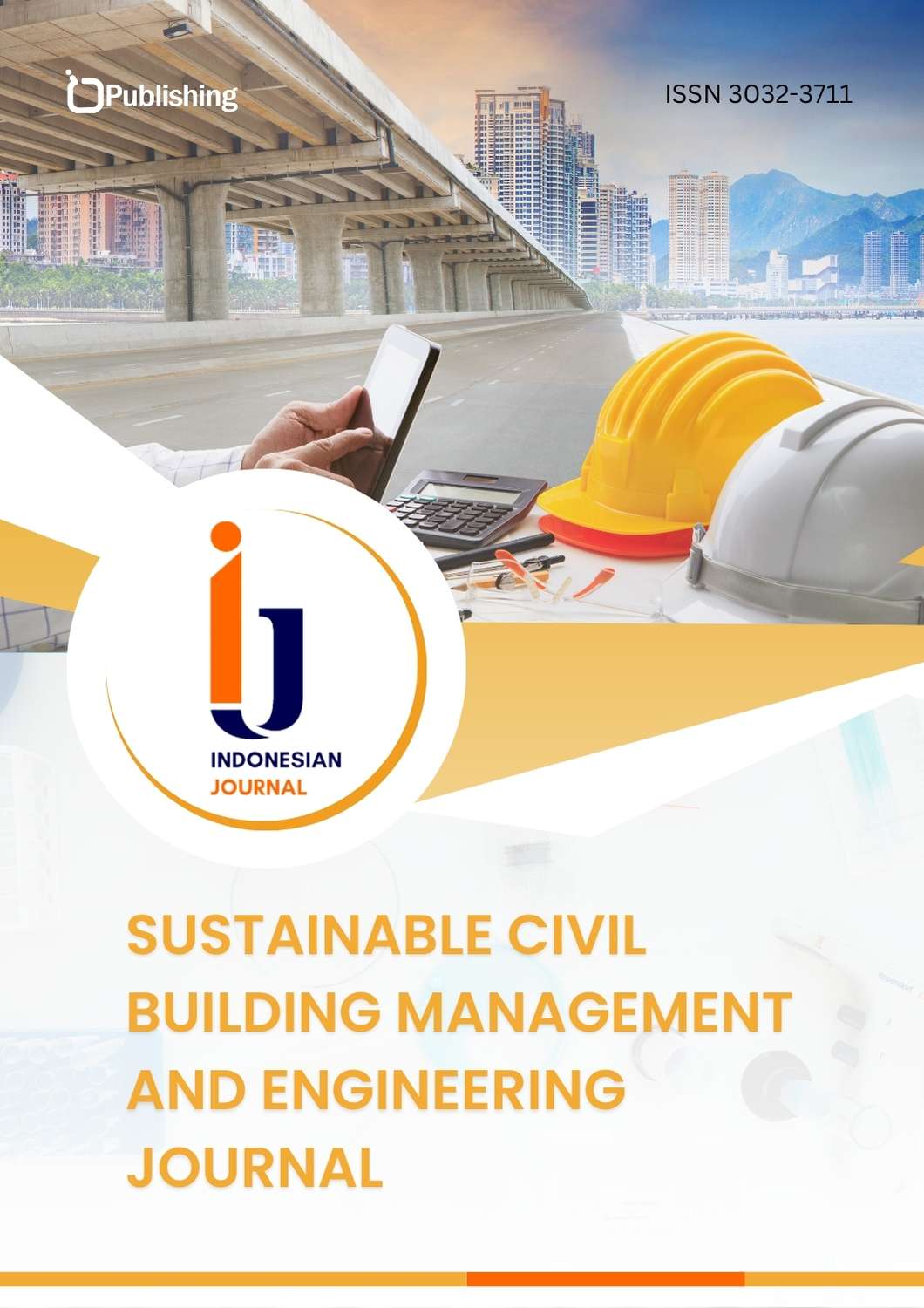Checking For Condensation Formation on The Inner Surface of The External Walls of Frame Buildings Made of Thermal Blocks
DOI:
https://doi.org/10.47134/scbmej.v2i3.4193Keywords:
Energy Efficiency, Thermal Block, Frame Building, Heat Transfer Resistance, Basalt Insulation, Condensation, Thermal BridgeAbstract
This study investigates the use of T-shaped thermal blocks composed of fine-grained concrete and basalt slabs to enhance the energy efficiency of frame buildings. Although frame structures are widely used in modern construction for their economic and structural advantages, improving the thermal performance of their external walls remains a critical challenge. This research addresses the knowledge gap by analyzing the structural composition, thermal resistance, and condensation prevention properties of multilayer thermal blocks. A combination of experimental assessment and numerical heat transfer modeling was conducted under the climatic conditions of Samarkand using SmartCalc ThermoCalc. The results demonstrate that the use of basalt insulation and thin adhesive joints significantly reduces thermal bridges and enhances heat retention. The calculated heat transfer resistance of the wall sections exceeded the required norm (Ro ≥ 2.2 m²·°C/W), and simulations showed no condensation on the inner surface even at -15°C, ensuring indoor comfort. These findings imply that T-shaped thermal blocks are an effective, locally sourced solution for sustainable and thermally resilient construction. This has practical implications for reducing energy consumption, operational costs, and environmental impact in cold climates
References
Bolikulovich K. M. Study оf the Thermal Conditions of Connections of Window Blocks to a Wall. – 2023.
Bolikulovich, K. M., & Bakhodirovna, R. D. (2023). Methodology for Calculation of the Temperature Field in the External Fencing Structures of Buildings.
Calculation of the Temperature Field of External Enclosing Structures Using The Finite Difference Method. (2024). Innovative: International Multidisciplinary Journal of Applied Technology (2995-486X), 165-169.
Gayrat Shukurov, Khaitov Maruf Bolikulovich, Fazilov Farkhod Holiyevich, Kulmirzayev Jaxongir Ilxomiddinovich, M. Alvan Rizki; Innovative solutions for the use of aerated concrete blocks in residential buildings. AIP Conf. Proc. 24 July 2024; 3167 (1): 060013. https://doi.org/10.1063/5.0221137
Gil, A. (2017). CSPonD demonstrative project: Start-up process of a 25 kW prototype. AIP Conference Proceedings, 1850, ISSN 0094-243X, https://doi.org/10.1063/1.4984477
https://www.stonebldg.com/understanding-the-importance-of-building-enclosures-in-construction/
Invidiata, A. (2018). Selecting design strategies using multi-criteria decision making to improve the sustainability of buildings. Building and Environment, 139, 58-68, ISSN 0360-1323, https://doi.org/10.1016/j.buildenv.2018.04.041
Khaliq, W. (2022). Performance evaluation for energy efficiency attainment in buildings based on orientation, temperature, and humidity parameters. Intelligent Buildings International, 14(5), 606-622, ISSN 1750-8975, https://doi.org/10.1080/17508975.2021.1873096
Khayitov, M. B. (2021). Thermal insulation materials: advantages and production. ISJ Theoretical & Applied Science, 01 (93), 375-378.
Konstantinov, A. (2018). Providing thermal protection when replacing window blocks in historical buildings. IOP Conference Series: Earth and Environmental Science, 177(1), ISSN 1755-1307, https://doi.org/10.1088/1755-1315/177/1/012019
Kornilov, T. (2021). Evaluation of the effectiveness of additional thermal insulation of the basement floor of frame-monolithic buildings in extreme operating conditions. E3S Web of Conferences, 263, ISSN 2555-0403, https://doi.org/10.1051/e3sconf/202126304041
Kumar, V.G. (2020). A study report on carbon sequestration by using Hempcrete. Materials Today: Proceedings, 45, 6369-6371, ISSN 2214-7853, https://doi.org/10.1016/j.matpr.2020.11.012
Makhmudov M., Rustamova D. Uniformity Check of the Thermal Conductivity Coefficient of Brick and Plaster Used in the Manufacture of Fragments of Experimental Walls for Studying Heat Protective Qualities // Journal of Advanced Scientific Research (ISSN: 0976-9595). – 2021. – Т. 1. – №. 1
Makhmudov, M., Rustamova, D. & Nosirova, S. (2021). Empirical dependence of sorption humidity of keramzybeton concrete on relative humidity of air. European Journal of Research Development and Sustainability (EJRDS). Available Online at: https://www.scholarzest.ComVol, 2
Mamadaliyev, X. E., Khaitov, M. B. & Fazilov, F.X. (2024). Prospects for the Use of Coal Ash in the Construction Industry. International Journal of Scientific Trends, 3(2), 45–48.
Pulatovich, M. B. (2021). Energy Efficient Building Materials for External Walls of Residential Buildings Physical Properties of Heat. International Journal of Culture and Modernity, 9, 1-11.
Rezvanpour, M. (2023). Generalizable Thermal Performance of Ventilated Block Walls and Energy Implication of Substitution for Wood-Frame Walls in Cold-Climate Buildings. Buildings, 13(7), ISSN 2075-5309, https://doi.org/10.3390/buildings13071577
ShNQ 2.01.01-22. Climatic and physical-geological data for design.
ShNQ 2.01.04-18. Construction heat equipment.
Siddaiah, R. (2020). Virtual Prototyping of MV HV Modular Multilevel Power Converter using evolutionary Optimization based on ? ?. ECCE 2020 - IEEE Energy Conversion Congress and Exposition, 3532-3539, https://doi.org/10.1109/ECCE44975.2020.9235467
Siddaiah, R. (2021). Virtual Prototyping Process for Assessment of Medium Voltage Grid-Connected Solid State Transformer Implementations. 2021 IEEE Energy Conversion Congress and Exposition, ECCE 2021 - Proceedings, 1156-1163, https://doi.org/10.1109/ECCE47101.2021.9595786
Toma, V.V. (2021). The effects of thermal insulation on the interior noise level during the day. A case study of a 1960 block of flats located in downtown Bucharest. IOP Conference Series: Earth and Environmental Science, 664(1), ISSN 1755-1307, https://doi.org/10.1088/1755-1315/664/1/012097
Turakulovna, E. M., & Pulatovich, M. B. (2023). Improving the energy efficiency of the external walls of residential buildings being built on the basis of a new model project. Open Access Repository, 4(2), 187-193.
Tusnina, V.M. (2024). THERMAL EFFICIENCY OF EXTERNAL WALLS STEEL BUILDINGS WITH BALCONIES. Light and Engineering, 32(1), 63-69, ISSN 0236-2945, https://doi.org/10.33383/2023-073
Urbikain, M.K. (2020). Energy efficient solutions for retrofitting a residential multi-storey building with vacuum insulation panels and low-E windows in two European climates. Journal of Cleaner Production, 269, ISSN 0959-6526, https://doi.org/10.1016/j.jclepro.2020.121459
"Manual for designing new energy-saving solutions for building thermal engineering (to KMK 2.01.04-97*)" / JSC "ToshuyjoyLITI" - Tashkent, IVC "AQATM", 2012.











